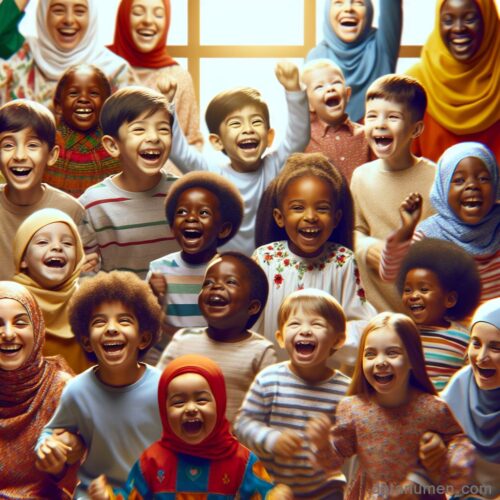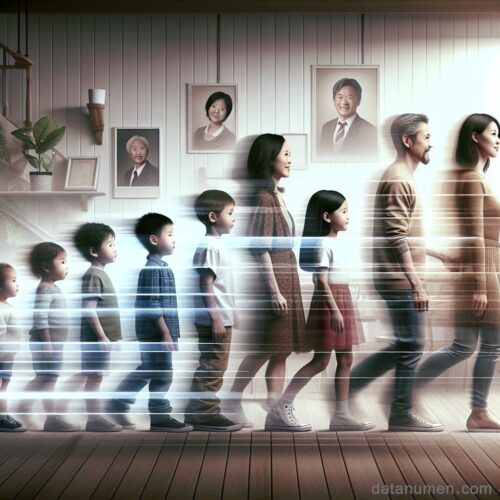1. Childhood Joy
During their early years, the children in the family experienced a sense of pure happiness. Their days were filled with laughter, play, and innocence. They found joy in the simplest of things, from running through fields to chasing butterflies. The world was a magical place for them, full of wonder and excitement.
Every day was an adventure, and they embraced it with open hearts and curious minds. They built forts out of blankets, explored the woods behind their house, and played make-believe for hours on end. Their imaginations knew no bounds, and they could turn any ordinary moment into something extraordinary.
Whether it was splashing in puddles after a rainy day or tasting ice cream for the first time, their childhood was marked by moments of pure delight. They were surrounded by love, care, and warmth, which nurtured their spirits and allowed them to thrive.
As they grew older, they would look back on those carefree days with fondness, cherishing the memories of their childhood joy. Those moments would become a source of comfort and strength during the challenges that lay ahead. But for now, they lived in the present, savoring every moment of their carefree and joyful youth.

2. Growing Apart
As time went by, the dynamics within the family began to shift. Each member started to evolve in different ways, leading to a gradual drifting apart from one another. The once close-knit bond that held the family together began to weaken, affected by the changes that came with age and personal growth.
Perhaps it was due to diverging interests or new life priorities that caused the family members to grow apart. The siblings who used to spend hours playing together now found themselves pursuing their own individual paths. The parents, who once provided a pillar of strength and guidance, now faced their own challenges that consumed their attention.
Communication became sparse as everyone became engrossed in their own lives, forgetting to make time for each other. Celebrations and family gatherings that used to be a regular occurrence began to feel more like obligations rather than joyous occasions. The shared memories and traditions that once bound the family together were now distant echoes of a past that seemed almost unreachable.
Despite the growing distance between them, there remained a tinge of nostalgia for the closeness that once defined their family. Each member yearned for the days when they felt connected and united, but the reality of their current situation only emphasized how much they had drifted apart.

3. Unveiling Differences
As the group dynamics continued to evolve, the true nature of each individual began to emerge. Strengths, weaknesses, quirks, and insecurities were all revealed, contributing to both positive interactions and negative conflicts within the group.
On one hand, the unveiling of differences allowed for a deeper understanding of each team member, fostering empathy and camaraderie. It provided an opportunity for individuals to appreciate diversity and recognize the unique perspectives that each person brought to the table. This newfound awareness led to more effective communication and collaboration, ultimately enhancing the overall productivity and creativity of the group.
However, the exposure of individual differences also brought about challenges. Conflicts arose as contrasting personalities clashed, leading to misunderstandings and tension. Different approaches to problem-solving and decision-making caused friction, hindering progress and creating obstacles to achieving common goals. In some cases, unresolved conflicts escalated and threatened to divide the group, jeopardizing the unity and cohesion that were essential for success.
In summary, the process of unveiling differences within the group had both positive and negative consequences. While it allowed for a deeper understanding and appreciation of individual uniqueness, it also presented challenges in the form of conflicts and misunderstandings. Managing these differences effectively was crucial in determining the group’s ability to work together harmoniously and achieve its objectives.

4. Silent Disconnection
Communication broke down, leading to silence between the family members.
Impact of Silent Disconnection
The lack of communication within a family can have detrimental effects on the relationships between its members. When communication breaks down and silence ensues, feelings of isolation, resentment, and misunderstanding can grow. Without open and honest communication, conflicts are left unresolved, leading to a buildup of tension and further distance between family members.
Causes of Silent Disconnection
Silent disconnection can be caused by a variety of factors, including unresolved conflicts, lack of trust, emotional barriers, and poor communication skills. Additionally, external stressors such as work pressures, financial problems, or health issues can contribute to the breakdown of communication within a family. When these issues are not addressed and communicated effectively, it can lead to a state of silence and disconnection.
Overcoming Silent Disconnection
To overcome silent disconnection within a family, it is essential to prioritize open and honest communication. This includes actively listening to one another, expressing emotions and concerns, and working together to resolve conflicts. Establishing trust, setting boundaries, and seeking professional help if needed can also aid in repairing and strengthening familial relationships. By addressing the root causes of silent disconnection and actively working towards better communication, families can rebuild connections and foster a healthier dynamic.

5. Transformation Begins
Through the challenges they face, each family member starts to transform and grow individually.
The Impact of Challenges
As the family navigates through various challenges, they are faced with situations that push them out of their comfort zones.
Personal Growth
Individually, each family member begins to undergo a transformation, realizing their strengths and weaknesses as they tackle obstacles head-on.
Building Resilience
Through overcoming difficulties, the family members learn to adapt, grow, and thrive in the face of adversity.
Embracing Change
With each hurdle they conquer, the family members start to embrace change and discover new possibilities for personal development.
Strength in Unity
Despite facing their own individual challenges, the family members find strength in their unity, supporting each other through their transformative journeys.

Leave a Reply